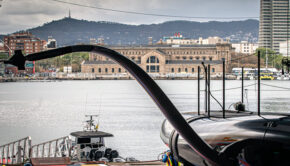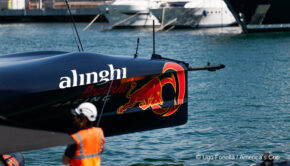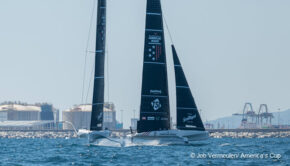America’s Cup: Exploring new territory
Published on May 6th, 2020
As the America’s Cup challenger American Magic (USA) remains off the water at their Florida winter due to health guidelines, the team has made the decision to move their operations sooner than planned from Pensacola to New Zealand.
With the coronavirus restrictions easing in Auckland, the schedule has their AC75 DEFIANT on a 35-day ship transport for an early June arrival, and once all the people are moved and in place, on the water a month later.
With their second boat finishing construction in Bristol (RI), the team expects for to come out of the shed in late August, get on a plane for transit to New Zealand in September, and be on the water in early-to-mid October.
The design and development of this new foiling monohull class rule finds the team exploring new territory in preparation for the 36th America’s Cup… here an update:
In September 2019, American Magic’s DEFIANT became the first AC75 to both sail and foil on the waters of Narragansett Bay, Rhode Island. Since then, the first of two AC75s to be built for the U.S. America’s Cup Challenger has been in a “shakedown” phase, where the complex and cutting-edge systems have been tested and refined.
Also part of this groundbreaking period has been the shakedown of the human element; the training of some of the world’s first AC75 sailors. American Magic’s team of grinders, trimmers, and other specialists have been recruited from the best of Olympic, foiling, and previous Cup classes, but sailing onboard DEFIANT is unlike anything else.
“Liftoff on the AC75 is surprising compared to a Moth, SuperFoiler, GC32, or the other mainstream foiling boats out there now,” said trimmer/grinder Dan Morris (Newport, RI). “Liftoff on this boat feels like an airplane.
“When [helmsman] Dean Barker, [main trimmer] Paul Goodison, [flight controller] Andrew Campbell and the grinders are in sync, the boat takes off like an airplane on a tarmac. There’s acceleration, the bow comes up, and the boat lifts free. In most other foiling boats the takeoff is a labored effort, with the boat ‘working hard’ to take off. The AC75 feels easy and smooth.”
The level of teamwork required to get the boat up on its foils, sailing at full pace, and running through maneuvers is formidable. Each of the 11 crew onboard continually work to execute their tasks in sync.
“The sailors in the two sides of the cockpit are in some ways in their own little worlds,” said trimmer/grinder Trevor Burd (Marblehead, MA). “With the deck-sealed main you can’t verbally communicate across the boat. This is where the trust factor comes in.
“Going into a maneuver without your side of the boat having confidence that the guys on the other side of the boat are ready for it would create problems. The good news is that you know that the sailors over there are the best in the world, and you know they’ll be ready.”
The athletes powering DEFIANT’s hydraulic systems are focused on much more besides generating the “oil pressure” that is crucial for trimming and turning the boat. A deep knowledge of tactics, situations, and the boat’s systems is a necessary tool for everyone onboard.
“You can’t just be an athlete, or just a power source, on an AC75,” said Burd. “You have to know and be ready for the maneuver before it happens, and be able to anticipate. Each maneuver or adjustment has steps, requires understanding of what the boat needs and you need to be prepared for what is going to happen.
“If you don’t have those factors you get behind in your tasks, and then the maneuver doesn’t happen, stuff breaks, or both. You gotta be ‘heads up’.”
For the dozens of members of American Magic’s Bristol, Rhode Island-based production team, who poured tens of thousands of hours into the team’s first AC75 build project, seeing DEFIANT perform as expected is a source of satisfaction.
“It’s a proud moment to see our hard work doing exactly what it is designed to do,” said Brandon Linton (Newport, RI), the team’s Boat Construction Manager.
“Usually there is a feeling of finality when a yacht completes all structural load testing and finally sails for the first time, but with an America’s Cup yacht it is just the beginning of a new phase of optimization and modification. The yacht build is never completely finished until the last race.”
With the 2020 America’s Cup World Series (ACWS) circuit curtailed by the COVID-19 pandemic, the team has been focused on design work, the production of the second AC75, and the logistical move to Auckland ahead of ACWS Auckland, the Prada Cup, and the America’s Cup. It’s never far from the thoughts of team members that by this stage in the year, they expected to be fresh off their first regatta in Cagliari, Italy.
“We really can’t wait to go racing,” said Morris. “On a scale of 1-10, our team is at 11, itching to be on the water. We were prepped and ready [to race] this spring, with everything geared towards performing in Cagliari.
“There were just waves of anticipation. You think it’s coming, and you try to peak physically and mentally for a regatta like that. To have that first event delayed, the anticipation just builds and builds inside our team.”
36th America’s Cup
In addition to Challenges from Italy, USA, and Great Britain that were accepted during the initial entry period (January 1 to June 30, 2018), eight additional Notices of Challenge were received by the late entry deadline on November 30, 2018. Of those eight submittals, entries from Malta, USA, and the Netherlands were also accepted. Here’s the list:
Defender:
• Emirates Team New Zealand (NZL)
Challengers:
• Luna Rossa (ITA) – Challenger of Record
• American Magic (USA)
• INEOS Team UK (GBR)
• Malta Altus Challenge (MLT) – WITHDRAW
• Stars + Stripes Team USA (USA)
• DutchSail (NED) – WITHDRAW
Of the three late entries, only Stars+Stripes USA remains committed, but they still must complete the entry fee payment process before they will be eligible to race. They have allegedly made their initial payment but as a late entry challenger under the Protocol, they also have a liability to pay a US$1million late entry fee due in installments by October 1, 2019. However, it is not yet confirmed if they have paid the fee, nor is there any knowledge of a boat being actively built or sailing team training.
Key America’s Cup dates:
✔ September 28, 2017: 36th America’s Cup Protocol released
✔ November 30, 2017: AC75 Class concepts released to key stakeholders
✔ January 1, 2018: Entries for Challengers open
✔ March 31, 2018: AC75 Class Rule published
✔ June 30, 2018: Entries for Challengers close
✔ August 31, 2018: Location of the America’s Cup Match and The PRADA Cup confirmed
✔ August 31, 2018: Specific race course area confirmed
✔ November 30, 2018: Late entries deadline
✔ March 31, 2019: Boat 1 can be launched (DELAYED)
✔ 2nd half of 2019: 2 x America’s Cup World Series events (CANCELLED)
✔ October 1, 2019: US$1million late entry fee deadline (NOT KNOWN)
✔ February 1, 2020: Boat 2 can be launched (DELAYED)
✔ April 23-26, 2020: First (1/3) America’s Cup World Series event in Cagliari, Sardinia (CANCELLED)
✔ June 4-7, 2020: Second (2/3) America’s Cup World Series event in Portsmouth, England (CANCELLED)
December 17-20: Third (3/3) America’s Cup World Series event in Auckland, New Zealand
January 15-February 22, 2021: The PRADA Cup Challenger Selection Series
March 6-15, 2021: The America’s Cup Match
AC75 launch dates:
September 6 – Emirates Team New Zealand (NZL), Boat 1
September 10 – American Magic (USA), Boat 1; actual launch date earlier but not released
October 2 – Luna Rossa (ITA), Boat 1
October 4 – INEOS Team UK (GBR), Boat 1
Details: www.americascup.com









 We’ll keep your information safe.
We’ll keep your information safe.